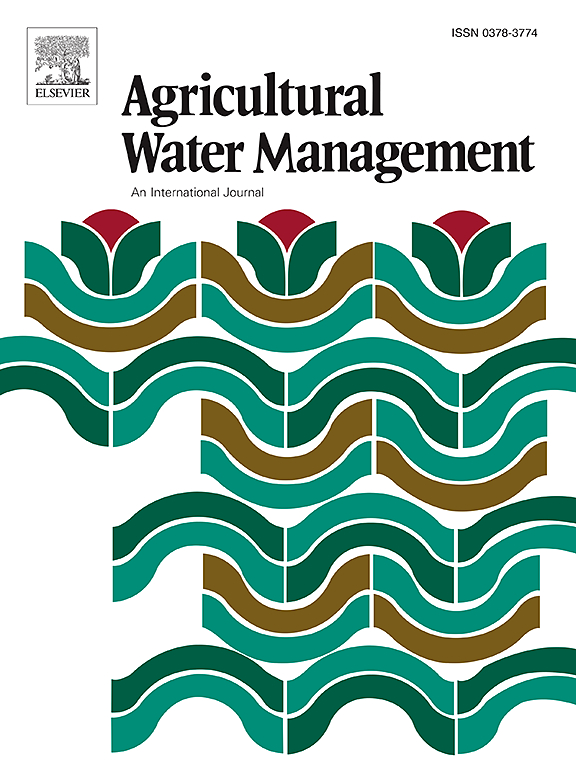水平垄作加覆盖是减少莫利溶岩山坡地表径流和水土流失的最佳耕作方法
IF 5.9
1区 农林科学
Q1 AGRONOMY
引用次数: 0
摘要
气候变化导致降水量和降雨侵蚀性增加,加剧了土壤侵蚀,尤其是在全球中高纬度地区。然而,在作物幼苗期,这些地区的年降水量通常比较集中,人们对土壤侵蚀过程和适当的耕作方法还不甚了解。在降雨强度为 50 毫米/小时和 100 毫米/小时的条件下进行了模拟降雨试验,以研究玉米苗期保护性耕作和常规耕作措施(包括玉米秸秆覆盖(Cm)、水平垄作(Hr)、水平垄作+覆盖(Hr+Cm)、垂直垄作+覆盖(Vr+Cm)、垂直垄作(Vr)和平耕(CK))对 5° 山坡土壤侵蚀的影响差异。结果表明,作物在幼苗期可以通过改变雨滴的分布和降低其动能来减少土壤侵蚀。与传统耕作措施相比,保护性耕作措施大大减少了径流总量(11.7%-100%)和沉积物产量(71.1%-100%),推迟了径流-产量开始时间(85 秒-26.1 分钟),降低了径流速度(71.5%-96.7%),并减少了径流和土壤流失率。地膜覆盖比 Hr 效果更好。它通过降低径流速度和土壤颗粒过滤,减少了泥沙浓度(70.6 % ∼ 100 %)。等高线山脊在 100 mm h-1 时比 50 mm h-1 时更早断裂,为地表径流提供了更大的沉积物来源,从而改变了土壤侵蚀的特征。影响土壤侵蚀的关键因素是径流速度,而不是土壤的可侵蚀性。降低径流速度比控制径流量更重要。Hr + Cm 处理的土壤侵蚀程度最低,建议在坡耕地的玉米苗期采用。我们的研究结果为减轻中国东北地区春季土壤侵蚀提供了一种优化的耕作方法。本文章由计算机程序翻译,如有差异,请以英文原文为准。
Horizontal ridging with mulching as the optimal tillage practice to reduce surface runoff and erosion in a Mollisol hillslope
Soil erosion is amplified by the increased precipitation and rainfall erosivity caused by the changing climate, particularly for global mid-high latitude areas. Yet soil erosion processes and proper tillage practices are not well understood at the crop seedling stage, when the annual precipitation is usually concentrated in these regions. Simulated rainfall experiments were conducted at the rainfall intensities of 50- and 100-mm h−1 to investigate the differences in soil erosion of a 5° hillslope during the maize seedling stage between conservation and conventional tillage measures, including cornstalk mulching (Cm), horizontal ridging (Hr), horizontal ridging + mulching (Hr+Cm), vertical ridging + mulching (Vr+Cm), vertical ridging (Vr) and flat-tillage (CK). The results demonstrated that crops, at the seedling stage, can reduce soil erosion by altering the distribution of raindrops and reduce its kinetic energy. Conservation tillage measures significantly reduced total runoff (11.7 %–100 %) and sediment yield (71.1 %–100 %), delayed runoff-yield start time (85 s–26.1 min), decreased runoff velocity (71.5 %–96.7 %), and reduced runoff and soil loss rates, compared to conventional tillage measures. Mulching showed better performance than Hr. It reduced sediment concentration (∼70.6 %–100 %) by reducing runoff velocity and soil particle filtration. The contour ridge ruptured earlier at 100 mm h−1 than at 50 mm h−1 and changed the characteristics of the soil erosion by providing a larger source of sediment for surface runoff. Runoff rate, rather than soil erodibility, was the key factor affecting soil erosion. Decreasing runoff velocity was more important than controlling the amount of runoff. The Hr + Cm treatment exhibited the lowest soil erosion and is recommended for adoption at the maize seedling stage in sloping farmland. Our findings provide an optimized tillage method to mitigate soil erosion in spring in Northeast China.
求助全文
通过发布文献求助,成功后即可免费获取论文全文。
去求助
来源期刊

Agricultural Water Management
农林科学-农艺学
CiteScore
12.10
自引率
14.90%
发文量
648
审稿时长
4.9 months
期刊介绍:
Agricultural Water Management publishes papers of international significance relating to the science, economics, and policy of agricultural water management. In all cases, manuscripts must address implications and provide insight regarding agricultural water management.
 求助内容:
求助内容: 应助结果提醒方式:
应助结果提醒方式:


